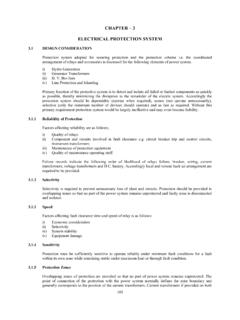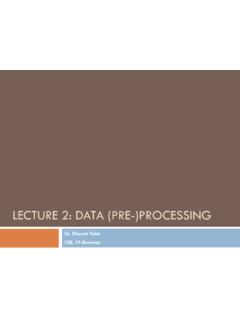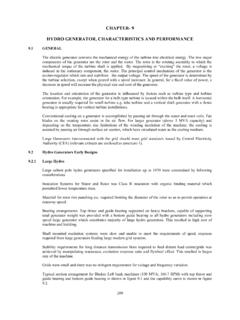Transcription of CHAPTER-8 SWITCHYARD EQUIPMENT- HV Bus Bars, …
1 CHAPTER-8 . SWITCHYARD EQUIPMENT- HV Bus Bars, SWITCHYARD Structures, Isolating Switches, Current Transformers, Voltage Transformers, Lightning Arresters Introduction Outdoor step up substations at hydroelectric stations are provided to step up power at generated voltage generally for interconnection with the grid to evacuate power. Generation voltage varies from 415 volts to 11 kV (or higher) and step up voltage of small hydro up to 5 MW capacity may not exceed 36 kV. In case of large hydro stations the step up voltage may be up to 420 kV. SWITCHYARD equipment comprises of main equipment, ancillary equipment and SWITCHYARD structures. Step up transformers and circuit breakers are discussed in Section 6 & 7. Insulators SWITCHYARD structures, isolating switches current and voltage transformers and lightning arrestors are discussed in this chapter.
2 Auxiliary equipment for switchyards is common with powerhouse auxiliary and discussed in Section II (Chapter 4 & 5). Standards and Codes Relevant National Standards (Latest edition) are as follows: IS: 9920 Part I to IV Alternating current switches for rated voltages above 1000 volts and less than 52 kV. IS: 9921 Part 1 to 5 Alternating currents disconnectors (isolators) and earthing switches rating, design, construction, tests etc. IS: 1893 Criteria for Earthquake resistance design of structures IS: 2705 Part 1 to 4 Current transformer IS: 3156 Part 1 to 4 voltage transformer IS: 3070 part 1 to 3 Lightning arrestors IS: 2544 Porcelain insulators for system above 1000 V. IS: 5350 Part III post insulator units for systems greater than 1000 V.
3 IS: 5621 Hollow Insulators for use in electrical equipment IS: 5556 Serrated lock washers specification IS: 3716 Application guide for insulation co-ordination IS: 2165 Phase to earth insulation co-ordination General Requirements General The equipment is designed and manufactured to provide most optimum functional value and neat appearance. All major assemblies or equipment is designed to facilitate easy and quick surveillance, maintenance and optimum operation. All control sequences is simple and rational. All live, moving and rotating parts are adequately secured in order to avoid danger to the operating staff. All electrical components are electrically earthed. Suitable lifting eyes and forcing off bolts are provided where required or where they will be useful for erection and dismantling.
4 Seismic Consideration Forces caused by earthquake which may occur for the seismic intensity of the zone concerned are taken into account. Stresses resulting after including these loads should not exceed permissible stresses. For Himalayan region projects it is specified as under:- SWITCHYARD equipment and structure be designed to safely withstand earthquake acceleration force both in the vertical and horizontal direction in most Himalayan region. For other regions refer IS: 1893. 397. Basic Insulation Level and Insulation Coordination This is discussed in Para for equipment up to 220 kV and Para for EHV equipment for 420 kV. Insulators Provision of adequate insulation in a substation is of primary importance from the point of view of reliability of supply and safety of personnel.
5 However, the station design is so evolved that the quantity of insulators required is the minimum commensurate with the security of supply. Creepage Distance: An important consideration in determining the insulation in a sub-station, particularly if it is located near sea or a thermal power generating station or an industrial plant is the level of pollution. As a first step to combat this problem special insulator with higher creepage distance is used. In case this does not suffice, washing the insulators by using live line equipment has to be resorted to and this aspect has to be kept in mind while deciding the layout of the substation. Another method which has proved to be successful in some countries involves the application of suitable type of greases or compounds on the surface of the insulators.
6 This, however, also requires cleaning of insulation, the frequency depending upon the degree and the type of pollution. The creepage distances for the different pollution levels are provided according to table Table : Creepage distance for different pollution levels Pollution Level Creepage distance (mm/kV of Recommended for adoption highest system voltage) (mm). Light 16 25 x highest system voltage (kV). Medium 20 up to medium pollution level Heavy 25. Very heavy 31. For determining the creepage distance requirement, the highest line-to-line voltage of the system forms the basis. Insulator Type Types of insulators used: A) Bus Support Insulators i) Cap and Pin type ii) Solidcore type iii) Polycone type B) Strain Insulators i) Disc insulators ii) Long rod porcelain insulators iii) Polymer insulators SWITCHYARD Structures The cost of structures also is a major consideration while deciding the selection of a substation.
7 For instance, in the case of the strain/flexible bus-bar arrangement, cost of structures is much higher than in the case of rigid bus type. Similarly the form of structures also plays an important part and the choice is usually between using a few heavy structures or a large number of smaller structures. While finalizing the design, size and single line diagram of structures, safety clearance requirements should be ensured. Steel is the most commonly used material in India for substation structures. Normally the steel structures are hot-dip galvanized so as to protect them against corrosion. However, galvanizing sometimes has not 398. proved effective, particularly in substations located in coastal or industrial areas and in such cases painting also becomes essential.
8 In other countries special paints have been developed which are applied within the shop and these paints have been quite effective. Design Data for Design of SWITCHYARD Structures Design Loads i) Wind Pressure on Structures (Refer table ). Maximum for the area on times the projected area of one face for latticed structures and on single projected area in the case of other structures. In coastal regions the wind pressure may be assumed as 170 ii) Wind Pressure on Conductor (according to area see table ) on two-thirds projected area. iii) Maximum tension of transmission line conductors strung from terminal tower to station structures or of strung buses for lines 33 kV and above kg. ( tamil nadu electricity board Practice - TNEB Practice).
9 Iv) Maximum spans adjacent to stations: a) Lines rated 66 kV and above . m b) Lines rated 33 kV and below m Table : Wind Pressure & Temperature Data The table below gives the values of wind pressure and maximum and minimum temperatures specified in different states, as per REC for design of structure. State Wind Pressure Zones Max. Min. ICE. Temp. Temp. Loading Kg/m2 0. C 0. C. Andhra Pradesh - 75 100 - 60 10 Nil Assam - - - 50 Nil Bihar - - 97 - 60 4 Nil Gujarat - 75 100 - 50 10 Nil Haryana - - - 150 50 (-) Nil Kerala - 75 - - 55 10 - Madhya Pradesh - 75 - - 60 Nil Maharashtra 50 75 100 150 65 5 Nil Karnataka 50 70 - - 10 Nil Orissa - 75 100 150 60 5 Nil Punjab - 100 - - (-) Nil Rajasthan - - 100 - 50 (-) Nil tamil nadu - 122 (-) 5 Nil Uttar Pradesh - 75 - 150 60 Nil West Bengal - 75 100 150 60 0 Nil 399.
10 Working Stresses a) for steel: Bending .. 1265 Shear .. 1265 b) for concrete 1 : 2 : 4. Bending .. Shear .. Bend .. Factor of Safety Indian Adopted by (TNEB) Recommended electricity Rules a. Fopr steel based on maximum loading conditions (on elastic limit for tension members and crippling load for compression members). As per TNEB. b. For R. C. on ultimate breaking load Practice c. For hand Moulded R. C. Factory of safety against overturning: a) Steel b) R. C. Slenderness Ratio (L/R). Ratio of unsupported length (l) to radius of gyration (r) should not exceed;. a) 140 for leg members b) 200 for other members having calculated stresses only and 250 for members having nominal stress only. Minimum Thickness for Steel Members Steel employed for structures open hearth steel with a high yield point and an ultimate strength of not than 3867 The following maximum stresses in kg/cm2 are assumed for outdoor structures, fabricated out of steel sections manufactured in India: i.









